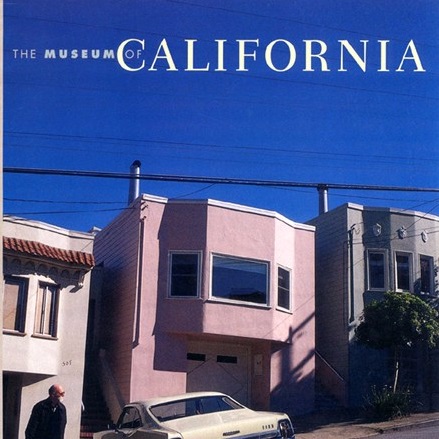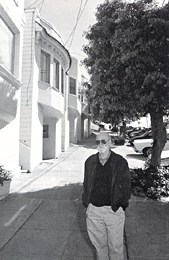Robert Bechtle: Hidden Reflections (2000)

Photograph of Robert Bechtle near his San Francisco home by Joe Samberg, 2000.
Robert Bechtle: Hidden Reflections (2000)
by Abby Wasserman
Robert Bechtle's sparkling California light and dense shadows, his gleaming American cars parked on empty streets, and his neat pastel row houses are like a reflection in someone's dark glasses. You see more of yourself than the wearer.
In his paintings people are often alone--a seated man, a woman starting to cross the street, a guy working at a table saw in the gloaming of his garage. Softening a severe geometry of street and houses are scallops of electrical wire sparkling with beads of sunlight (urban umbilical cords). Sometimes there are multiple vanishing points in the flatlands, or a hill so steep you can't see the top, which makes the world look tipped.
There's no feeling of dread in Bechtle's paintings, but there is an edge of curiosity about what's on the other side, if indeed there is anything. They have the look of stage settings, slightly unreal. Robert Bechtle is one of America's finest contemporary realist painters. He was born in San Francisco in 1932, grew up chiefly in Alameda, lived in Berkeley for some years, and is now back in San Francisco. He lives on Potrero Hill with his wife, art historian Whitney Chadwick, in a yellow stucco house behind a white picket fence. The street is so steep that parking is perpendicular. His studio is on the lower floor of the three-story house, with access to the garden. It faces east towards the Bay Bridge and Oakland hills.
On sunny days Bechtle roams Potrero Hill with his Nikon, looking for scenes to photograph which he may one day decide to paint. He begins by photographing "with a painting in mind. It's more than simply selecting any old photo. Rather, it's a slower and more deliberate process of choice."
Some of his paintings are composites of several slides, but most come from a single image.
The day he photographs has got to be sunny. He doesn't paint fog or rain, a conscious choice, he says. He likes the "jangliness" of extreme light and dark, the drama of very bright sunlight and deep shadows. He paints the streets, the boxy houses, the closed garage doors and shaded windows, the parked cars with dark interiors which seem to be waiting for their owners to activate them. One imagines that under the unblemished surfaces of those cars the engines sparkle.
He has a passion for precision and order. Whatever his city streets may be at other times of day, in other kinds of weather, during heightened activity, "Bechtle Time" is quiet, spare and almost suspended.

Robert Bechtle in 2000
Photo-Realism, though it's been around a long time, still occupies a somewhat uneasy position in the art world, but this may reflect a sense that art takes us "out of time," and in Photo-Realism the subject is very definitely "our time." Or there may be some uneasiness about the use of the camera, or a question such as, when the photograph has been composed and taken, why go further by making a painting that replicates it? One answer is that the photograph doesn't go far enough. The painting will express something beyond the photo.
"The photos often have a lot of detail that may be unreadable, and you learn to substitute or make up what's missing," Bechtle says. "The photo tells you more or less what's there. Your knowledge fills in the rest. Throughout the image, you have to translate into painting terms what was made through the camera and developed with chemicals.
"There's a certain sleight-of-hand in painting. You learn ways to suggest things rather than try to paint every leaf."
In the past, Bechtle says he tended to simplify color so that a patch of grass, for instance, had little modulation from its basic color. But these years he finds a world of color in everything. A stretch of pavement, for example, may appear to be flat gray in a photo, but in Bechtel's painting it will be flecked with many colors and appear quite alive, like the real thing--only better.
Once he has composed and taken a picture, his technique is to project the slide on a blank canvas and trace the outline of everything "to get it in place." He has an 11 x 14 Type C color print made from the slide, which will be his reference point thereafter. The painting then goes through several stages. He fills in the outlines in thin burnt umber so there's a fairly accurate monochrome drawing on canvas. Then, he says, "I go over that, referring to the photo, blocking in colors more or less like those in the photo, trying to get close but not worrying too much about it. I try to do this fairly rapidly. A month into the painting, it will essentially look the way it's going to look, but in a very rough way.
"I go back over the painting with arbitrary color touches. I splash in color, often complementary to what's there, until the painting has dots and dabs all over. As I'm painting on top of this, some areas will remain exposed. There's a slight element of chance in how it looks. It tends to look fairly naturalistic from a distance, but the colors--while muted and modified--are brighter than you think. There seems to be a little bit of every color everywhere. In every green, for example, there's always going to be a little red and blue. There's a kind of energy to the surface because of that."
When the painting is finished (and here's the "sleight-of-hand") the signposts of his technique have disappeared and one can only guess how it all came about.
Every artist eventually shows himself through obsessions, subject matter and handling. Part of what Bechtle reveals in his paintings is that he loves California, feels nostalgia for the era of his youth, and craves clarity, cleanliness and order. He finds beauty in things many of us would hardly look at. Here's a parked car, a stretch of pavement, a stop sign, a row house, a telephone wire--but in his paintings they shimmer. They are eloquent. The light is warm, the sky is bright blue, the car has noble lines, and all's right with the world.

Ingleside House by Robert Bechtle
On the wall of his studio Bechtle displays a series of little watercolors done in Italy en plein air. He used to do watercolors as a student at CCAC in Oakland, and recently has gone back to it, especially when he's away from home, because he enjoys the looseness and speed watercolor allows. "You have to work faster because of changing light, and my attention span is shorter when working outside. The little paintings take one to one and a half hours. They force me to see what I'm seeing very fast. The large studio paintings can take six months and can be tedious after awhile. You want to move on to something new, but have to keep going until it is right. The little watercolors are like a vacation, a way of setting a different kind of challenge. The two kinds of work play off each other."
These watercolors were never meant to be public, he says, "which left them open to struggles. I could make mistakes. It didn't matter because no one would see them."
Bechtle is often grouped with Richard Estes and Malcolm Morley, Photo-Realists also interested in the machines of our culture; but his bright exterior light brings Edward Hopper to mind. Hopper's work is emotional, with disturbing situations, while Bechtle deliberately leaves out explicit emotion and conflict. In the early years, in fact, he and other Photo-Realists strove for "complete neutrality" and a bland light, "the look of California suburbia." He later changed from frontal light to side and back light, which demand more of the painter; the camera doesn't see as much detail in the foreground when there is a strong back light.
"At a certain point I thought, why not?" he says. "Why not let it be a little more dramatic? I started to shoot into the sun or into partial shadow and partial sun. There was something fascinating in setting up a situation where the background was dark, almost black, though with a sense that something was almost to be seen, with a brightly lit figure placed in front. I was looking at certain Renaissance paintings that used that effect.”
"I don't think of myself as consciously introspective," he continues, "but on a certain level, I think I am, at least in the sense that the work can be about a lot of things on different levels at the same time. On one level there is a personal nostalgia, remembering growing up in California with a certain feeling of place. On another level they're about American vernacular suburban culture. The choices of color, shape, and how the painting is put together--all of these are basically frameworks upon which the real enterprise is hung. The real enterprise is to allow some interior feeling to come out. It seems that whatever qualities these paintings have is because of how they are colored by unconscious interior feeling. I'm painting something I know and have deep connections with. They trigger a visual poetry that is not really about the subject matter. When successful, it sings in a certain way, with a particular edginess, melancholy, sense of absence and time standing still. There's the introspective quality, something hidden and revealed at the same time."
Yes: the bright, tell-all sunshine that casts such dark, protective shadows, the clean, transparent windows with their pulled-down shades. Hopper reveals the world behind the shades; Bechtle keeps us guessing.
Images from top:
- Cover photograph of Robert Bechtle near his San Francisco home by Joe Samberg, 2000.
- Black and white photograph of Robert Bechtle by Joe Samberg, 2000.
- Ingleside House by Robert Bechtle, 1975. Watercolor on paper, 8.25 x 11.5 in. Collection of the Oakland Museum of California, Museum Donors Acquisition Fund. Photographed by M. Lee Fatherree.
Originally published in The Museum of California magazine.
No reproduction without express written permission of the Oakland Museum of California.